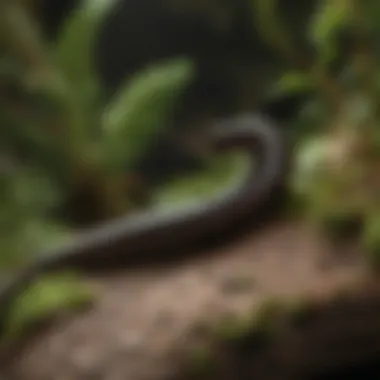Understanding Millipedes: Ecology, Behavior, and Solutions


Intro
Millipedes are often misunderstood organisms that can sometimes make their way into our homes. Understanding their presence is essential for any homeowner. They are a vital part of the ecosystem, breaking down organic matter in nature. Despite their environmental impact, their intrusion into living spaces can cause discomfort or unwanted stress. This article will provide insights into why millipedes invade our homes, their behavioral traits, and offer practical, environmentally friendly solutions for their management.
Animal Profile
General Overview
Millipedes are arthropods that belong to the class Diplopoda. Unlike their familiar cousin, the centipede, millipedes have two pairs of legs per body segment, giving them their distinctive, elongated appearance. They are not insects, but their biological makeup shares some similarities. Typically, millipedes are not harmful to humans or pets, but their mere presence can lead to concern and confusion.
Habitat and Distribution
In the wild, millipedes are commonly found in moist environments, such as forests, gardens, and leaf litter. They thrive in decaying wood and leaf matter, where they play a key role in nutrient cycling. Their presence in homes usually indicates that they are searching for moisture. In various regions of the world, including North America and Europe, millipedes can be found during specific seasons, often emerging after rainfall or heavy humidity.
Fascinating Facts
Unique Traits and Adaptations
Millipedes exhibit several interesting traits. They can curl up into a ball when threatened, offering some protection from predators. Additionally, many species can release a noxious fluid from special glands, deterring potential threats. This defensive mechanism plays a crucial role in their survival.
Historical and Cultural Significance
Historically, millipedes have been present since the Paleozoic Era. They are important in various cultures as symbols of resilience and adaptability. Their impact on soil health and decomposition has been recognized by agricultural practices, where they contribute significantly to soil fertility.
Conservation Status
Current Population Trends
The population trend of millipedes is relatively stable in most regions. However, habitat destruction and climate change pose potential risks to their ecosystems. Increasing urbanization can lead to habitat loss, potentially resulting in localized dwindling populations.
Threats and Challenges
Aside from habitat loss, millipedes face challenges from pollution and changing climate conditions. Use of chemicals in gardening and agriculture can also affect their survival, highlighting the need for eco-friendly practices in pest control. Ensuring their well-being can ultimately enhance beneficial ecological processes.
Care Tips for Homeowners
Basic Needs and Requirements
For homeowners looking to manage millipede presence, it is crucial to understand their basic needs. They seek moisture and organic material. Keeping your home less hospitable to them involves reducing dampness and removing any organic materials from areas near entry points.
Health and Wellness Tips
Maintaining a clean and dry environment is the first step to prevent an influx of millipedes. Regularly inspect basements, attics, and crawlspaces for excess moisture. Using dehumidifiers can help reduce humidity levels. If millipedes enter your home, vacuuming them up is often the best immediate solution, as it is non-toxic and effective.
Managing millipedes involves understanding their natural behavior and ecology, allowing for effective coexistence and control without harmful chemicals.
In summary, recognizing millipedes’ role in the ecosystem and implementing natural pest-control measures can lead to a healthier living environment. Understanding these fascinating creatures, their behaviors, and their needs is the key to cohabitation, ensuring that we can manage their presence effectively.
Preface to Millipedes
Understanding millipedes is crucial for homeowners and professionals concerned with pest management and home ecology. These arthropods, commonly found in moist environments, often wander into homes in search of better conditions. Recognizing their habits and biological traits can help mitigate their presence effectively, whether you are an educator, student, or wildlife biologist.
Millipedes are not insects but belong to the class Diplopoda. They are characterized by their elongated bodies and numerous segments, each typically bearing two pairs of legs. Unlike centipedes, which can exhibit more aggressive behavior, millipedes are generally harmless to humans and pets. They mainly feed on decaying organic matter, playing a vital role in the ecosystem by aiding in decomposition. However, their capacity to invade homes often raises concerns, necessitating a deeper understanding of their nature and habits.
Key elements of millipede study include their behavior, habitat preferences, and environmental impact. Knowing when and why they invade can help homeowners take proactive steps to prevent infestations. This information is particularly relevant for those looking to employ eco-friendly management strategies that do not rely on harmful chemicals.
Benefits of understanding millipedes include:
- Identifying invaders: Recognizing millipedes assures that homeowners distinguish them from other pests.
- Preventive measures: Knowledge about millipede habits allows for effective barriers and environmental adjustments.
- Health and safety: While they pose minimal threat, it’s beneficial to understand their potential allergens.
In summary, exploring the intricacies of millipedes equips homeowners and professionals with the knowledge necessary for effective control and coexistence. This understanding lays the groundwork for subsequent sections, which will further detail their biology, behavior, and practical management techniques.
The Biology of Millipedes


Understanding the biology of millipedes is critical for homeowners dealing with their presence in living spaces. This knowledge offers insights into their behavior, reproduction, and environmental needs. A deep dive into their biology not only educates homeowners but also aids in developing effective strategies for prevention and control. By grasping their life cycle and physical characteristics, individuals can appreciate the ecological role millipedes play and mitigate any intrusions they may cause.
Physical Characteristics
Millipedes are distinct in appearance and have several key traits that set them apart from other arthropods. They typically have elongated bodies with many segments. Each body segment can bear two pairs of legs, contributing to their name, which means 'thousand feet' in Latin, although they usually have considerably fewer. Studying their specific features can help in identification. For example, some millipedes are smooth and shiny, while others are rougher or exhibit varied colors like brown, black, or even vibrant hues in certain species. Their segmentation can be a defining feature; counting the segments may help experts distinguish between species with similar behaviors and habitats.
Life Cycle
The life cycle of millipedes consists of several developmental stages, beginning with eggs. Female millipedes lay these eggs in moist, protected areas, often in soil or decaying vegetation. After hatching, young millipedes, called instars, resemble miniatures of adults but are usually pale in color. They shed their exoskeleton multiple times as they grow, gradually developing their characteristic features and darkening as they mature. This process can take several months to years, depending on environmental factors. Understanding this cycle can give insight into when millipedes are more likely to invade homes. For instance, during the moist seasons, they emerge from their hiding places to mate and search for food.
Habitat and Distribution
Millipedes thrive in various habitats, showing adaptability to different environments. They are typically found in moist, shaded areas such as leaf litter, under rocks, or in decaying logs. Their distribution is widespread, found in numerous regions across the world. Most commonly, they inhabit temperate to tropical zones. Moisture is essential for their survival, driving their dwelling behaviors. In urban areas, millipedes often migrate towards homes, especially in search of damp conditions. By recognizing these factors, homeowners can take preemptive actions and reduce the likelihood of an invasion. For insights on the global distribution of millipedes, you may visit Wikipedia, which provides detailed ecological context.
Why Millipedes Enter Homes
Understanding why millipedes invade homes is crucial for effective prevention and management. Millipedes are generally harmless, yet their presence within our living spaces can indicate underlying environmental factors. They are often attracted by specific conditions that promote their entry into homes. By grasping these reasons, homeowners can implement strategies to deter such intrusions.
Moisture Attraction
One primary reason millipedes are drawn inside is the moisture found in our homes. Millipedes thrive in humid environments, and damp areas provide ideal conditions for their survival. Basements, bathrooms, and even kitchens often have high humidity levels, making them breeding grounds for these creatures. It's important to note that millipedes can also be found near leaky pipes, wet soil, or standing water, creating a direct route for them to enter homes.
To combat this, homeowners should regularly check for plumbing leaks and ensure proper ventilation in bathrooms and kitchens. Dehumidifiers or fans can significantly reduce moisture levels, minimizing the appeal these areas have for millipedes.
Searching for Shelter
Millipedes are primarily nocturnal and tend to seek refuge during the day. As temperatures rise or environmental conditions change, millipedes search for shelter. Homes provide a comfortable environment away from predators and harsh weather, making them an attractive option.
During particularly dry or hot spells, millipedes might venture inside seeking cooler temperatures. They can easily find their way in through cracks in walls, gaps around doors, or unsealed windows. Thus, sealing potential entry points is an effective strategy to keep them out.
Availability of Food Sources
Besides moisture and shelter, the availability of food sources also plays a significant role in millipede invasions. Millipedes mainly feed on decaying plant matter, fungi, and soil organic matter. Gardens, especially those rich with mulch or compost, can attract millipedes in large numbers. If these areas are adjacent to the home, it becomes easy for them to migrate indoors, particularly in search of a more stable food source or if conditions in their natural habitat become unfavorable.
Maintaining a distance between garden beds and the foundation of your home is one way to limit this food source for millipedes. Raking leaves and removing debris can also reduce their numbers outdoors, lessening the chance of indoor infestations.
By understanding the reasons millipedes enter homes, homeowners can take informed steps to reduce their allure and prevent unwelcome infestations.
Common Areas of Entry
Identifying the common entry points for millipedes is essential for efective management and prevention strategies. Understanding where these pests are likely to invade helps homeowners take proactive measures and minimize their presence within living spaces. Millipedes are attracted to dark and moist environments, which makes some areas of a home more susceptible to infestation than others. This section will explore three key areas in detail, maximiizing the understanding of their behavior and environmental preferences.
Basements and Crawl Spaces
Basements and crawl spaces are particularly vulnerable to millipede invasions. These locations often have higher humidity levels, providing an ideal habitat for milipedes. Additionally, they are typically dark and secluded, offering shelter from predators. Homeowners should regularly check these areas for signs of millipede activity, such as exoskeletons and droppings.
To reduce the appeal of these spaces, maintaining proper drainage and ensuring ventilation is crucial. Installing dehumidifiers can help regulate moisture levels, making the environment less hospitable for millipedes. It is also important to seal any cracks or gaps in the foundation where millipedes could enter.
Key Actions:
- Maintain moisture levels
- Ensure good ventilation
- Seal cracks in foundations
Bathrooms and Kitchens
Bathrooms and kitchens are common areas where millipedes might be found, as they are often moist and warm. Areas around sinks, bathtubs, and under appliances can be particularly inviting. Food sources for millipedes may also be found in kitchens, such as decaying organic matter.
Homeowners should pay close attention to plumbing leaks and standing water. Regularly cleaning and maintaining these areas will eliminate any potential food sources and decrease humidity. Using exhaust fans during showers can help reduce moisture buildup, making these environments less appealing for millipedes.
Considerations for prevention:
- Address plumbing leaks promptly
- Clean to remove food sources
- Use exhaust fans to reduce humidity
Garden and Landscaping Effects


The outdoor environment significantly affects millipede presence indoors. Gardens and landscapes can serve as gateways for millipede entry. Mulch, leaves, and moist soil create an attractive habitat outside. When conditions are favorable, millipedes may migrate indoors seeking shelter.
Implementing barriers such as installing gravel or stone borders can help deter millipedes from moving into homes. Additionally, keeping gardens tidy by regularly removing debris and moist organic material can diminish their chances of thriving nearby. It is also advisable to place plants that millipedes do not favor in proximity to the house.
Outdoor management techniques:
- Install gravel or stone barriers
- Regularly remove garden debris
- Choose less attractive plants for landscaping
By addressing these common areas of entry and implementing preventive measures, homeowners can significantly reduce the chances of millipede invasions in their living spaces.
Factors Influencing Millipede Invasions
Understanding the factors influencing millipede invasions is essential for effective management. Millipedes are sensitive to environmental conditions. Their presence can be more pronounced during certain seasons. Homeowners must identify these elements to develop targeted prevention strategies.
Seasonal Changes
Seasonal changes greatly impact millipede behavior and population dynamics. In cooler months, these creatures tend to seek shelter. They look for warm and humid areas. As spring arrives, interest in seeking refuge increases. Adult millipedes often migrate indoors after heavy rains. This migration mainly occurs in the late spring and autumn, coinciding with moisture levels in the environment.
These patterns are essential in predicting when millipedes are likely to invade homes. Identifying these patterns allows residents to be more vigilant. Changes in temperature and humidity can guide preparedness. For instance, if a rainstorm is forecasted, homeowners can take preventive actions before the seasonal influx of millipedes occurs.
Environmental Conditions
Environmental conditions play a significant role in influencing millipede invasions. High humidity levels create an inviting atmosphere. Millipedes thrive in moist, decaying organic matter. Therefore, areas with poor drainage are more likely to attract them. Homeowners should pay attention to the landscape around their property. Keeping organic debris, such as leaves or mulch, away from the foundation will help. This practice reduces the chances of millipedes taking refuge.
Furthermore, soil composition is an important consideration. Heavily mulch gardens increase moisture retention. This condition is perfect for millipedes, which are drawn to decaying plant material. Placing barriers or reducing excessive moisture can mitigate potential invasions.
"Understanding the environmental preferences of millipedes allows for strategic preventive measures."
In summary, both seasonal changes and environmental conditions are critical in understanding millipede invasions. Recognizing these factors will aid in limiting millipede presence in homes. Thus, monitoring environmental conditions regularly paves the way for effective preemptive actions.
Impacts of Millipedes in Your Home
Understanding the impacts of millipedes in your home is crucial for homeowners who wish to maintain a comfortable living environment. While these creatures are generally harmless, their presence can pose some lesser-known challenges. This section will highlight the potential property effects and possible allergen concerns associated with millipedes. Awareness of these impacts can help in better management and prevention strategies.
Lesser Known Effects on Property
Millipedes are often underestimated when it comes to their impact on property. Although they do not cause structural damage like termites or carpenter ants, they can still affect your home in indirect ways. Their decomposing bodies can contribute to unpleasant odors and attract other pests. Furthermore, the secretion from millipedes, when disturbed, can leave a stain on surfaces, particularly on floors and walls. This staining can become a problem over time if not managed properly.
Moreover, it is important to consider the role millipedes play in the ecosystem. As detritivores, they help decompose organic matter. While this is beneficial for the environment, excessive accumulation indoors could lead to a disruption. The increased organic material they bring, along with their frass (waste), may encourage the growth of molds and other fungi, creating additional challenges in maintaining a tidy and safe home.
"Millipedes serve a purpose in nature, but their indoors presence can complicate a healthy home environment."
Potential Allergens
Another concern with millipedes is their potential as allergens. While there is limited research on this specific issue, some individuals may be sensitive to the secretions millipedes release as a defense mechanism. This secretion can irritate the skin or respiratory tract upon contact. Symptoms may range from mild skin rashes to more severe allergic reactions in sensitive individuals.
Homeowners should be aware of any unexplained allergic reactions that could be related to these creatures. Proper hygiene practices, such as frequent cleaning and vacuuming, can help minimize any risks associated with allergens from millipedes. Ensuring that areas of the home are dry and well-ventilated can also limit the likelihood of millipede invasions and reduce the risk of exposure to potential allergens.
In summary, while millipedes are not typically a direct threat, their presence in your home can lead to indirect consequences that warrant attention. Understanding these impacts fosters a proactive approach in managing potential inconveniences while allowing a coexistence with these creatures.
Prevention Strategies
Prevention strategies are crucial for managing and mitigating millipede invasions in your home. Understanding these strategies helps homeowners effectively reduce the conditions that allow millipedes to thrive. In addition, these methods promote a safer environment by minimizing the need for chemical treatments. Proper implementation leads to long-term solutions and a more comfortable living space.
Moisture Control
Moisture control is one of the most important steps to prevent millipedes. These creatures are inherently attracted to damp environments. Here are several techniques for maintaining lower moisture levels:
- Regularly check and repair leaks. Small leaks in pipes or fixtures can create a habitat for millipedes.
- Ensure proper drainage in your home. Water should flow away from the foundation, not towards it.
- Use dehumidifiers in areas with high humidity. This will help maintain dryness to keep millipedes at bay.
The significance of moisture control cannot be overstated as a dry environment directly discourages millipede habitation.
Sealing Entry Points


Sealing entry points is another effective strategy for preventing millipedes from entering your home. Investigate and fortify the areas where millipedes may gain access. Important steps include:
- Inspect doors and windows for gaps. Installing weather stripping can help prevent entry.
- Check for cracks in walls or foundations. A simple caulking can do wonders for sealing those gaps.
- Look around pipes and utility lines entering the house and seal any spaces with appropriate materials.
By taking these actions seriously, homeowners greatly reduce the likelihood of millipedes finding their way inside.
Landscaping Techniques
Landscaping techniques also play a significant role in millipede prevention. The way you arrange your outdoor spaces can influence the presence of moisture and shelter, which attracts these creatures. Consider the following landscaping approaches:
- Keep mulch and debris away from the foundation of your home. This minimizes hiding spots and moisture retention.
- Maintain proper drainage in gardens. Waterlogged areas are encouraging for millipedes.
- Choose plants that retain less moisture. Certain varieties may naturally keep the surrounding soil drier, making it less inviting to millipedes.
Taking these landscaping measures contributes to a less hospitable environment for millipedes.
Effective prevention measures can establish a barrier against millipedes and other pests. A proactive approach will lead to a healthier home.
Natural Control Methods
Natural control methods offer an effective approach to managing millipede populations in your home. These strategies focus on ecological balance rather than chemical intervention, providing a safer environment for both residents and local wildlife. By utilizing natural predators and homemade remedies, homeowners can mitigate millipede presence while maintaining harmony in their living spaces.
Beneficial Predators
In the realm of natural pest control, beneficial predators serve a vital role. Several species naturally prey on millipedes, helping to maintain their populations in check. Some of these include:
- Ground beetles: These insects are effective hunters, targeting millipedes in both soil and leaf litter.
- Centipedes: While often mistaken for millipedes, centipedes consume these creatures as part of their diet.
- Certain birds: Also feed on millipedes, especially during the breeding seasons when dietary needs increase.
Implementing a habitat that attracts these beneficial predators can significantly reduce millipede sightings within your home. Maintaining a healthy garden ecosystem can encourage the presence of predators. Native plants and diverse plant life create habitats where these predators thrive.
Homemade Remedies
Homemade remedies can also be effective in controlling millipede populations. These methods are environmentally friendly and easy to prepare. Here are a few popular options:
- Soap and water solution: Mixing soap with water can create a solution that suffocates millipedes on contact. Use a spray bottle for easy application in areas where millipedes have been spotted.
- Diatomaceous earth: This natural powder can be sprinkled around entry points. It works by damaging the exoskeleton of the millipedes, leading to dehydration.
- Salt barrier: Creating a boundary using salt can deter millipedes from crossing. However, it's crucial to use this sparingly, as salt can harm surrounding plants and soil health.
By employing these natural control methods, homeowners can manage millipede populations effectively. The focus on ecological techniques not only benefits the home but also aligns with sustainable living practices. It is important to remember that some methods may take time to show results, but regular application and maintenance are key to fostering an environment less welcoming to millipedes.
Chemical Control Options
Chemical control options serve as a significant theme in managing millipede populations within residential settings. These methods can offer immediate solutions when other preventive measures have failed. The primary goal is to reduce pest presence efficiently while considering environmental impacts and human safety.
Insecticides Considerations
When considering insecticides for millipede control, it is crucial to select those specifically designed for soil-dwelling pests. Millipedes are often elusive, thriving in damp areas. As such, residual insecticides come into play. These products, which cling to surfaces and remain effective over time, can be particularly useful. However, one should be cautious of their usage. Some insecticides pose risks to non-target species, including beneficial insects and pets.
Key Points to Consider:
- Active Ingredients: Look for products containing bifenthrin or deltamethrin, as these are often effective against millipedes.
- Target Application: It’s important to apply insecticides directly in areas where millipedes are likely to hide, such as near baseboards, in crawl spaces, or along the edges of gardens.
- Follow Label Directions: Always read and adhere to the instructions on the label to ensure proper and safe usage.
Safe Application Practices
Safe application practices are essential to minimize potential harm to the environment and residents. Understanding how to handle chemicals is vital for effective intervention.
Practices to Follow:
- Personal Safety: Wear gloves, a mask, and protective eyewear when applying insecticides to avoid direct contact.
- Timing: Apply insecticides during dry weather to enhance effectiveness and prevent environmental runoff.
- Ventilation: For indoor applications, ensure proper ventilation to reduce inhalation risks.
- Storage: Store any unused insecticides in a secure location, away from children and pets, and at a suitable temperature to maintain their efficacy.
Remember, responsible use of insecticides can lead to effective millipede management while protecting other life forms.
Combining chemical control with environmentally friendly practices and preventive methods can create a balanced approach to managing millipede populations effectively.
Closure
In this article, we have examined the multifaceted nature of millipedes and their presence within our homes. Understanding millipedes is vital for a few specific reasons.
Firstly, awareness of these creatures promotes informed decision-making regarding pest management. Instead of reacting impulsively with harmful chemicals, homeowners can implement eco-friendly and natural strategies. By embracing preventive measures, such as moisture control and sealing entry points, individuals can effectively reduce millipede presence without detrimental impacts on the environment.
Secondly, recognizing the ecological role that millipedes play in the environment helps shift perspectives. They contribute to soil health by breaking down organic matter, enhancing ecosystems. This understanding cultivates a more harmonious cohabitation, enabling us to respect their role in nature while maintaining a comfortable living space.
Lastly, it is essential to consider the potential health implications associated with millipedes. While they are generally harmless, the discussions around allergens and contamination should not be disregarded. Hence, taking proactive steps towards prevention and management is crucial in creating a safe and healthy home environment.
"Knowledge is the first step to effective pest control."















